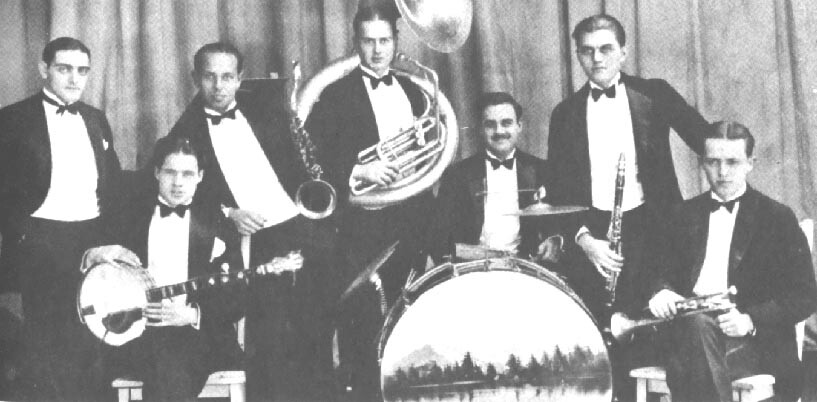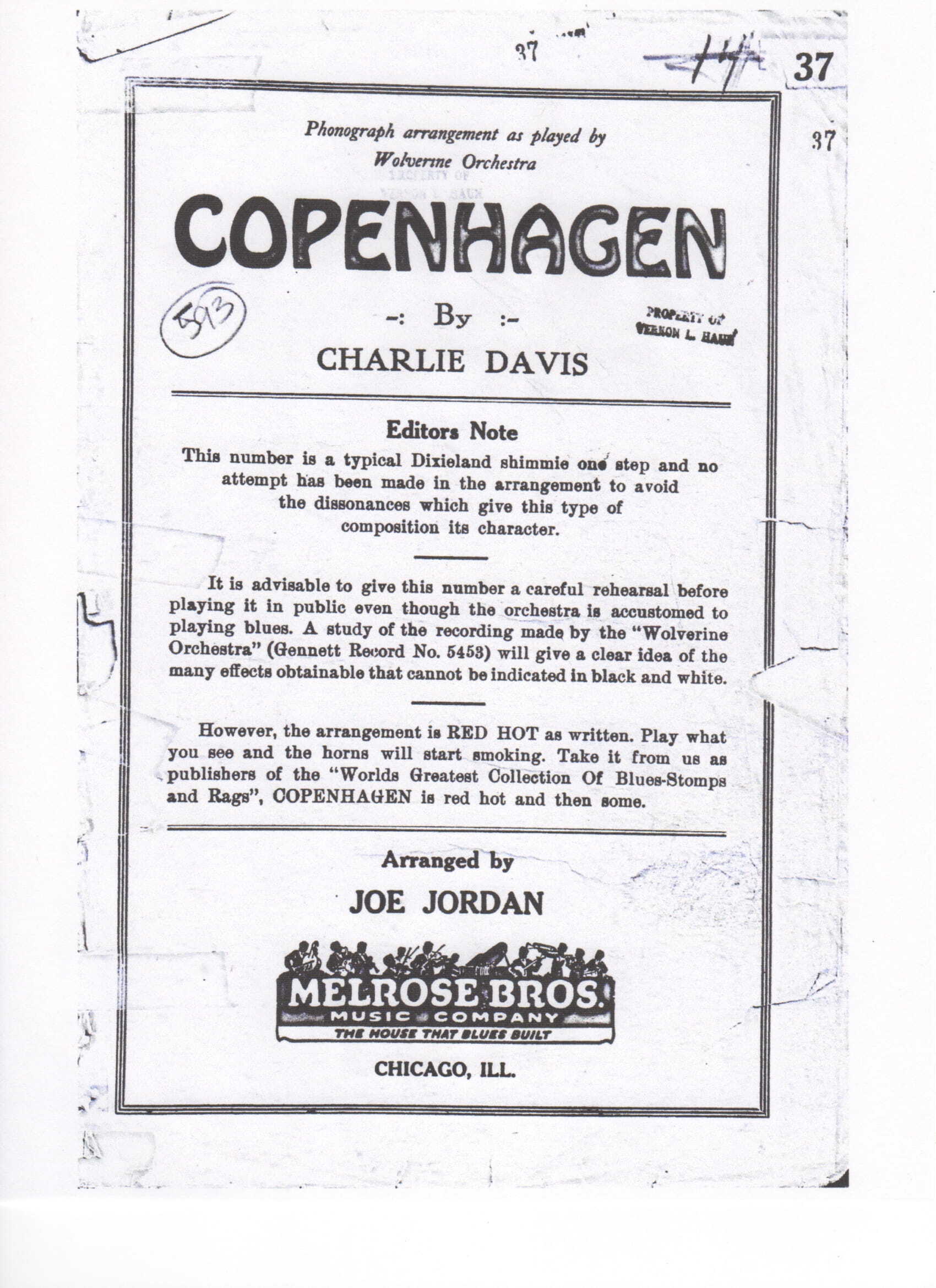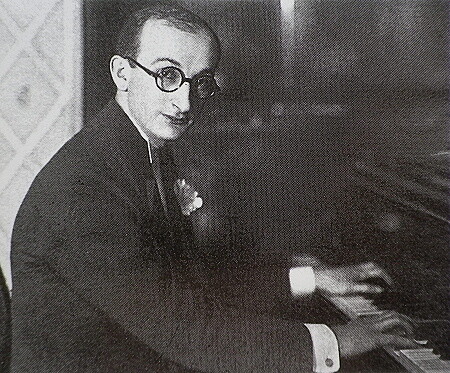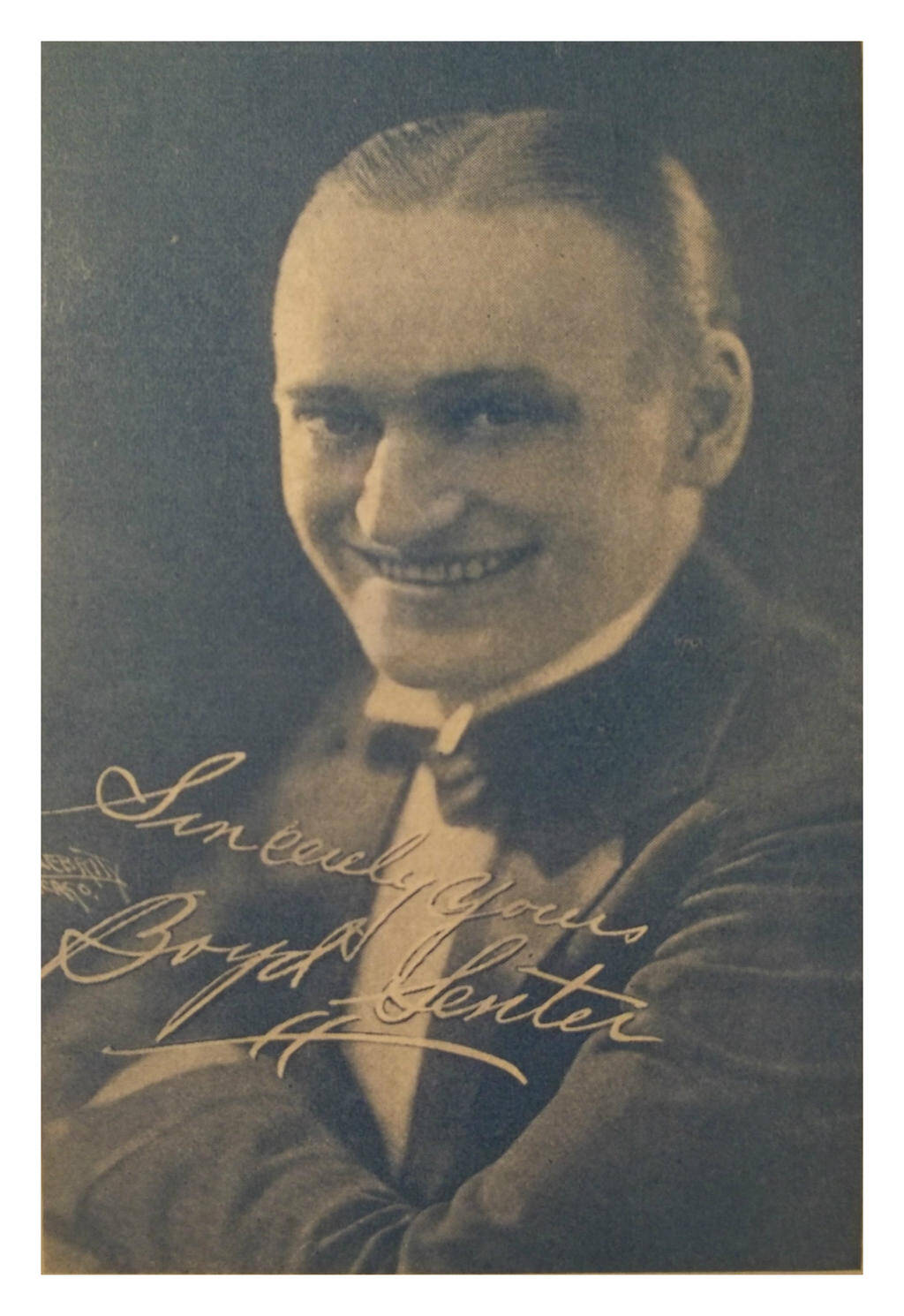Jeff Barnhart: Hal, we’ve wanted to return to an in-depth exploration of a single tune, and this one is the Mt. Everest of the classic jazz repertoire. Pick-up bands run scared from it, people argue at length about what section goes where, and the dozens of recordings from 1924 to the present jumble the sections around at will. Yes, it’s time to go to “Copenhagen!”
The tune’s origin is unusual in that a recording of it ignited huge interest in the piece. Traditionally, a lucky band would make a “hit” recording of an existing tune or the selection was an original composition by the bandleader and/ or one or more of the band members. In the case of “Copenhagen,” bandleader (and composer of the tune) Charlie Davis performed it with his Orchestra on April 5, 1924 at the Ohio Theatre in Indianapolis, IN. The piece might have remained in obscurity—Davis’ outfit failed miserably in their one attempt to record any piece in their repertoire—if not for notable members in the audience, specifically the Wolverine Jazz Band including cornetist/leader Leon “Bix” Beiderbecke. “Copenhagen” rocked them back in their seats; they requested it be repeated several times during the night and asked Davis his permission to record it, which he enthusiastically granted.
The Wolverines then played several gigs leading up to their May 6, 1924, recording date, including an engagement on April 18 where they played in a small room alternating sets with Charlie Davis’ outfit performing in the main ballroom and, according to Davis himself, stole the show. No doubt, with Bix’s coaching and encouragement, on their travels and gigs the band refined the arrangement of “Copenhagen” that they recorded in May.

Hal, I know you’re champing at the bit to cover that seminal recording in detail, but I’d like to quickly lay the groundwork for how we’ll identify each section of the tune. As the first anthem-like horn riff starts off a full-length 8 bar section that is usually played twice, making it an integral part of the piece, I’d rather call it section A then an Intro…that would make the blues chorus section B. As for the 16-bar section following the reprise of A, let’s call it “C” (Bix’s solo chorus). An 8-bar interlude (starting with the horn chorale) is performed twice, as is the section starting with Min Leibrook’s tuba solo, harmonically an arranged chorus of “B.” The Wolverines’ recording concludes with an ensemble “C” section, and a final 8-bar reprise of the chorale interlude with a double ending.
To sum: AA—BB—AA—C—Interlude—BB (tuba 4; ensemble 8)—C—1/2 interlude—double ending.
I’ve done the drudgery work of outlining the form of the Wolverines’ record; because you’re such a good friend, Hal, I invite to you to herewith revel in the delights within!
Hal Smith: Would you believe that on this seminal recording, they left out the “D” strain?!? (It’s the one with the awkward lyrics: “Pro-fessor man, won’t you play Co-pen-ha-gen.”) Even so, the Wolverines’ routine is a template for many future recordings of the song —the blues choruses by clarinet and tenor sax – are especially key elements of this arrangement. Of course, Bix sounds wonderful, beginning his chorus with a note that is bent almost double! And with the improved fidelity of the 21st Century, we can really hear Vic Moore’s drumming. His woodblock and choke cymbal playing really drives the rhythm section and his cymbal crashes are perfectly-timed. And speaking of the rhythm section…this may be one of the earliest recordings with a brass bass and guitar, rather than a banjo.
JB: You mention the clarinet and sax solos. Jimmy Hartwell’s clari solo sounds like a statement of a composed melody with a couple of filigrees, so I suggest this was a section of Davis’ composition that remained in the Wolverines’ version (this is NO critique of Hartwell: listen to his scorching contribution to the double ending!). Contrast that with tenor saxophonist George Johnson’s terrific, improvised solo that follows; many of the ensuing versions through the 1920’s contained that solo with little variation!
 Both choruses found their way into the stock arrangement, published by the Melrose Bros. Music Co. of Chicago, IL, and arranged by star pianist, conductor, and band leader Joe Jordan! As our colleague, Matthew de Lacey Davidson, pointed out in the June, 2022 issue of The Syncopated Times, these stock arrangements provided great springboards for orchestras and bands to use as much or as little as they pleased (or were capable of). Look at the front cover of the stock arrangement only to enjoy the carnival barker language of Melrose & Co.—“Play what you see and the horns will start smoking”— but also to note how closely the stock was associated with the Wolverines’ recording (“Phonograph arrangement as recorded by the Wolverine Orchestra”). This is a hyperbolic statement; there are numerous significant differences between the stock and the recording, suggesting an amalgamation of the Wolverines’ version and Charlie Davis’ actual composition.
Both choruses found their way into the stock arrangement, published by the Melrose Bros. Music Co. of Chicago, IL, and arranged by star pianist, conductor, and band leader Joe Jordan! As our colleague, Matthew de Lacey Davidson, pointed out in the June, 2022 issue of The Syncopated Times, these stock arrangements provided great springboards for orchestras and bands to use as much or as little as they pleased (or were capable of). Look at the front cover of the stock arrangement only to enjoy the carnival barker language of Melrose & Co.—“Play what you see and the horns will start smoking”— but also to note how closely the stock was associated with the Wolverines’ recording (“Phonograph arrangement as recorded by the Wolverine Orchestra”). This is a hyperbolic statement; there are numerous significant differences between the stock and the recording, suggesting an amalgamation of the Wolverines’ version and Charlie Davis’ actual composition.
I’ll be brief, but I hope outlining the biggest deviations will illuminate our continuing discussion. On the recording, bar three and bar four of the first section are played over the chords Eb (notes: Eb, G, Bb) and Gb7— Gb, Bb, Db, Fb (E)—respectively, while the stock utilizes a Cm (C, Eb, G) followed by a C minor7b5 (C, Eb, Gb, Bb). One wonders: did Bix mishear those harmonies from the Davis Orch. (NOT likely) or did he and the band decide their crunchier, more modern sounding progression to be a better choice? And since these chords ARE, at least to my ears, better choices, why didn’t they end up in the stock? Regardless, the chords on the Wolverine’s premier version disappear and for decades the stock chords remain. More confoundingly, as you pointed out, Hal, there is an entire section in the stock arrangement that does not appear on the recording.
The roadmap of the stock is: AA—BB—AA—C—Interlude—BB (tuba 4; ensemble 8)—D—1/2 interlude—double ending.
Melrose published both an orchestra “stock arrangement” and a piano/vocal song version. Although the vocal version contains the blues chorus (“Way down in old New Orleans”) in Eb, not in the key of Bb found in the stock and heard on the recording, both printed versions contain the section missing from the recording.
The Wolverine Jazz Band recording was released on May 31, 1924; the stock arrangement was submitted for copyright on October 1, with a vocal sheet music version (that transposes the blues chorus to Eb) submitted on October 28. Two versions of the stock were recorded in September, 1924; the absence of an actual date for one occludes certainty as to which was first. The Sammy Stewart band recorded “Copenhagen” in Chicago in September; their version is notable both for the absence of either Wolverine members Hartwell’s or Johnson’s blues statements—a new riff-melody for reed trio provides the platform for two choruses of hot muted trumpet—and for violin, then piano from leader Stewart playing over the famous tuba (here bass sax) riff.
On September 8, the Benson Orch. of Chicago recorded it in Camden, NJ; their version stands out for starting out slower and more sedate in classic hotel dance band fashion, with effective use of dynamics, but speeding up and reaching a certain level of heat by the end!
During October, two versions were recorded in Chicago. One featured vocalist Kitty Irvin singing Walter Melrose’s awful lyrics on a recording redeemed, as you pointed out, Hal, by the distinct probability that the pianist was our beloved “Kansas City” Frank Melrose, while the other was by Ted Fiorito’s and Don Russo’s outfit, the Oriole Terrace Orchestra, as covered by Matthew de Lacey Davidson in the June TST. The OTO’s version is played at a one-step tempo, so fast that they’re the first to have time to play through the D section twice! Davidson points out the accordion break on the 2nd “D” strain, but I was floored by the iconoclastic polytonal horn break on the 1st. WHERE did that come from?
Four versions were assayed in NYC in less than the span of a month. The Arkansas Travelers’ combines elements of the stock with the freedom of the Wolverines version (LINK). The Varsity Ramblers’ employs a Charleston rhythm in the A section and backbeats during the saxophone solo (as read right off the sheet), while the interlude has some strange almost gong-like susurration from drummer Stan King underpinning the horn chorale (LINK).
The New Orleans Jazz Band has a unique instrumentation: a sextet with no tuba, the trumpet executes the Johnson sax solo well and trombone takes the tuba break. As well, they play the final interlude twice before the double ending. (LINK) The standout, for its virtuosity and a veritable abandoning of the stock, is Fletcher Henderson’s seminal recording. Hal, take us through this one!
HS: Fletcher Henderson’s arrangement rearranges the parts. Instead of the usual introduction, he begins the arrangement with the “chorale,” repeated, then the blues chorus (B) is played by a clarinet trio. Next, young Louis Armstrong comes in swinging on a single chorus of (B). The effect of hearing Armstrong’s blazing hot chorus in the middle of the highly-arranged performance is like seeing all the fireworks ignite at once! Next, a variation on the original intro (A) is played by the ensemble, with a repeat. Trumpets take the C strain, followed by the “chorale”—with Armstrong playing over the top of the ensemble—and a repeat. Trombonist Charlie Green plays lead on the section where Min Leibrook played lead on sousaphone with the Wolverines, with a repeat. Then, we hear the previously “missing” D strain (thankfully, without vocal). The recording ends with interpolations of the “chorale,” the rearranged introduction and a “road to nowhere” coda similar to the one on “Sugar Foot Stomp.”
JB: It’s an awesome side! You reminded me that ace musician Don Redman was responsible for this exciting arrangement and your description of his innovations is spot on! I love both his quirkiness—the reed break on the C strain, the end of the C strain itself, and the fanfare of section A obstreperously invading the “chorale” section a bar early—and his sense of swing: having Buster Bailey jauntily riding in the chalumeau register over the chords of the D section (the melody is only hinted at by the brass) is very forward-looking! Finally, that music salad of an ending with all the intro and interlude material mixing in and ultimately devolving into the rhythmic pattern of the second bar of “A” descending chromatically to end on the chord E7 (NOT usually found in the key of Bb). Finally, modern technology affords us an opportunity to compare Bix’s and Louis’ solos—albeit on different sections—recorded less than six months apart and revealing why they were the two titans of the twenties.

We could spend an entire column on this one side alone, but there are further riches to explore! Of the recordings of “Copenhagen” released in 1925, three are notable for different reasons. The Alex Hyde New Yorker Jazz Band’s version is straight-ahead (emphasizing the word “straight”—it swings like an anvil) with the only interesting point being that it was recorded in Berlin, Germany (LINK). The Julian Fuhs Follies Band (also recorded in Germany) is taken at almost as fast a tempo as the OTO recording—this version is only 2:15 long and is almost note-for-note the same (minimally) altered arrangement as was recorded by the Alex Hyde ensemble (LINK). Far more interesting is the version by the British dance band The Savoy Orpheans. After assaying each of the sections in a moderate tempo, there’s a two-bar trumpet break that accelerates the tempo from fox-trot to one-step and takes us back to the A strain. We hear one chorus each of sections A, B, C, and D, the coda and double ending. When performed live, this arrangement was most likely used to accompany a professional dance demonstration and the band simply recorded it that way. I have to say, it’s weird but did make me sit up straighter.
So much for 1925. Let’s jump to 1929 to discuss in detail two fantastic renditions. Hal, with which would you like to start?
HS: I’ll go in chronological order, Jeff. Elmer Schoebel and his Friar’s Society Orchestra recorded “Copenhagen” in Chicago on Sept. 20, but it was rejected by Brunswick. They tried again on Oct. 18 and got a usable take (LINK). The record starts with the “chorale”—with Dick Feige blowing hot cornet over the melody as guitarist Charlie Barger strums sustained chords. The iconic Chicago clarinetist Frank Teschemacher plays two blues choruses which are full of references to Johnny Dodds and Jimmie Noone, with some Bix and Armstrong phrases too!
Tenor saxophonist Floyd Towne paraphrases George Johnson’s solo from the Wolverines’ record, then brings his own ideas into play. The ensemble plays the traditional intro, then an arranged variation on the D strain. Guitarist Barger plays the “C” strain (with an Eddie Lang-like whole-tone break), followed with repeats by Feige—sounding a lot like Jimmy McPartland—and the red-hot trombone of Jack Read, overlaid by surging reeds. Then the ensemble plays the “chorale” (with brass bassist John Kuhn jumping in a bit too soon) and a double ending with hot muted cornet. Note that here is another Chicago band with guitar and brass bass in the rhythm section. Ben Pollack and Benny Goodman were using that combination on their late-1920s recordings too. What stands out for you on this recording, Jeff?
JB: First, the solo phrasing and riffs throughout this hot ride are rhythmically smoother and more sophisticated than what we’ve experienced to this point. I love that Feige plays the Bix chorus quietly behind Barger’s solo even if he steps on the guitar break. Read’s trombone break into his solo chorus is a delightful surprise as is the continuation of the reed phrase during the break halfway through that same chorus! Virtuosity meets expert arranging for the swingin’est version yet! This is the first one I went back and listened to four times in a row. Two questions, Hal: was this Schoebel’s arrangement? How’ ya gonna top this one?
HS: As far as I know, it is Schoebel’s arrangement. By the way, this same chart was used by James Dapogny on his recording of “Copenhagen” in 1982.
The next record is by Boyd Senter and his Senterpedes. It was recorded in New York City but has plenty of hot Chicago elements. Senter first recorded it just 11 days after Elmer Schoebel, but—as happened to Schoebel—it was rejected. A second attempt, on Nov. 29, was successful. There are a few spots where it sounds like the signals were crossed regarding breaks, but despite that, this is one hard-driving version! The ensemble plays the traditional intro, followed by a blues chorus on A by the leader (sounding jazzier than usual) and a repeat with kazoo, backed by guitar.

Next, Fud Livingston on tenor sax leaps in playing an agitated Teschemacher-like syncopations, with Stan King accenting the syncopations on his snare drum. The ensemble repeats the intro twice, then trumpeter Mickey Bloom plays C. The ensemble returns with the “chorale”—with great drum fills and 4/4 banjo underneath—then trombonist Herb Winfield plays some rip-snorting variations on B. After that, the ensemble plays B with Stan King playing into Jack Russell’s Hines-style piano break. There is one more “chorale,” then the band goes all in for a double ending with Stan King laying into the bass drum on the afterbeats. I wouldn’t be surprised to find out that Fud was on clarinet there on the double ending—very reminiscent of the classic Chicago records by McKenzie and Condon’s Chicagoans, the Jungle Kings, Chicago Rhythm Kings, and Charles Pierce and his Orchestra.
JB: Another blistering track, but the heat is tempered by an almost laconic attitude. These musicians could play hot without breaking a sweat! You mention the trombone choruses; it’s a great convention to arrange a solo for four bars followed by eight bars of ensemble and Winfield’s first four bars galvanize the band to take no prisoners—Bloom’s trumpet hurtling down the chromatic scale on the ensemble of the first trade chorus stands out, and a bass clarinet can be heard in the second ensemble. Exhilarating stuff! I actually hear pianist Russell stepping on King’s planned drum break; Russell stops partway through!
Hal, we’ve covered the first five years of this amazing composition. It’s illuminating that bands in the 1920s-’30s would return to older material in addition to carving new paths with their music; the old stuff was THAT good! Next month, we’ll find even greater variation within the form and style of “Copenhagen” with performances by the likes of Earl Hines, Artie Shaw, Lu Watters, Kid Ory, Sidney Bechet and more!
Jeff Barnhart is an internationally renowned pianist, vocalist, arranger, bandleader, recording artist, ASCAP composer, educator and entertainer. Visit him online atwww.jeffbarnhart.com. Email: Mysticrag@aol.com
Hal Smith is an Arkansas-based drummer and writer. He leads the El Dorado Jazz Band and the
Mortonia Seven and works with a variety of jazz and swing bands. Visit him online at
halsmithmusic.com























